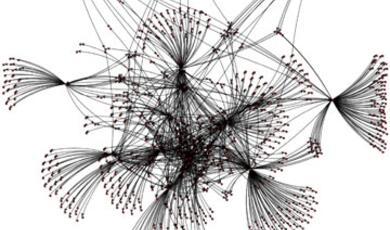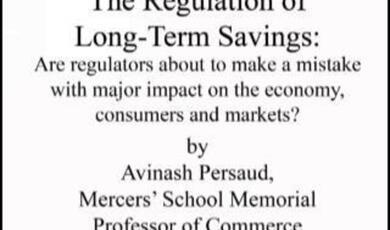Assessing the Economic Risks from Brexit
Share
- Details
- Text
- Audio
- Downloads
- Extra Reading
In this lecture, Professor Chadha, recently appointed as Director of the National Institute of Economic and Social Research, will consider how to interpret the published analysis on the consequences of a possible Brexit. While most studies (e.g. HMT and OECD) have highlighted the consequences for macroeconomic outcomes in terms of a set of point forecasts of real GDP per household, in this lecture Professor Chadha will consider how exit from the EU may affect the ability of the UK to share risk arising from macroeconomic shocks with the EU and the Rest of the World through trade in goods and assets.
Download Text
2 June 2016
Assessing the Economic Risks from Brexit
Professor Jagjit Chadha
"Given that there is a commitment to have a referendum, it is a good idea to have it earlier rather than later because a looming referendum feeds uncertainty. A vote to leave the EU may not impact much on growth in 2016, as many plans have already been formulated but would clearly involve a considerable reorientation of the economy, which is likely to be costly in the short run. The medium and long term prospects depend on access to the free trade blocs that make up the structure of world trade and the impact on financial and other services."
Mystery Economist Surveyed by FT in December 2015.
Introduction
I am delighted to address you this evening at Barnard's Inn on the 78th anniversary of the establishment of the National Institute of Economic and Social Research. Anniversaries are a moment to look back with fondness but also to look into the future and so I will take this opportunity to examine the economic question of the UK's membership of the EU. There are just three weeks to go until the referendum called by the Government on the question of whether the UK should remain in the EU. The vote will determine whether the UK seeks to leave a long-lived political and strategic supra-national relationship or continue to build a European Union. A narrow vote for Remain may, of course, lead to ongoing pressure for a further referendum but let's put that particular scenario to one side and consider how economics can help us clarify some aspects of this debate.
The question of regime change and its impact on economic outcomes is central to economic modelling. We model counterfactuals or conditional forecasts as do all scientists. To take an analogous example; a medic cannot tell you when you will die but she will be able to tell you that if you eat too much, smoke and drink too much you can expect to live n years less than you might otherwise have done. Indeed such a regime may have quite clear alternative consequences. And if I may ruin Dickens and re-write the famous opening lines from a Tale of Two Cities as an economic forecaster would have written them:
It will be the best of times, it will be the worst of times, it will be the age of wisdom, it will be the age of foolishness, it will be the epoch of belief, it will be the epoch of incredulity, it will be the season of Light, it will be the season of Darkness, it will be the spring of hope, it will be the winter of despair, we have everything before us, we have nothing before us, we are all going direct to Heaven, we are all going direct the other way.
Indeed you will also realise quite quickly that the debate on Leave or Remain is rather reminiscent of the "Travellers' Paradox". We are lost travellers who need to know which way to go at a fork in the road in order to arrive at a hotel at which our travel agent - who cannot be contacted - has made a group booking and we have a one-shot chance to ask which way to go from two guides working for two separate hotels standing at the fork. The guides naturally want us to go to their hotel but we do not know at which one we have the booking. If asked, each of the two guides will answer that we should go to their hotel. But only one will point us in the direction to which we ought to go. If we knew that one guide would always send us the wrong way and one the right way, there is actually a question we could ask that would yield the right answer: we ask both guides where would the other person send us. But the problem we face on this debate is considerably more vexing because we must assume that the guides do not themselves know to which hotel we should go. We shall return to this point shortly.
Let us briefly go back to the previous referendum in June 1975 at which time the National Institute Economic Review outlined a pretty horrific economic picture: [1] (i) We expect the total volume of world trade to fall by 6-7 per cent this year, (ii) Unemployment is likely to continue to rise rapidly, (iii) Between the second halves of 1974 and 1975 we expect GDP to rise by little more than 1/2 per cent; (iv) Private investment in total is forecast to fall by about 51 per cent this year; (v) Average earnings are forecast to rise by 25 per cent through this year and, following the budget measures, the retail price index is likely to show a similar increase. The economy looked rather like some nightmare raised from our worst fears. Indeed the Review started with:
Publication of this Review has been delayed by the dispute in the printing industry. The domestic forecasts were finalised in the first week of May, but a postscript at the end of this summary describes the economic indicators which have appeared between then and 26 May, and assesses their implications for the forecasts.
The economic backdrop to the previous referendum or indeed the decision to join the EEC seems to me to be intimately related to the observation of poor UK economic performance and the need to catch-up with the golden age of growth in mainland Western Europe in the 1950s and 1960s. Of course, the UK does not look quite so bad in terms of relative growth performance when compared to the EU average in the subsequent 40-odd years. Indeed it might well be our perceived poor performance against the faster growing emerging economies that motivates some wish to switch our economic attention away from the European Union. But as with all change, there is a risk that the projected benefits do not materialise in a sufficiently prompt manner and that the costs continue to accumulate.
Transmission Mechanisms
What are the economic stories connecting the UK and the EU? There are a number that have been explored in the literature. The most important one is precisely the original motivation for joining the Common Market in 1973: trade. Indeed during the period of membership of the Common Market our trading relations with the Community and then the Union have come to dominate our external position. The free movement of goods, services and labour allows the benefits of specialisation to be accrued (the so-called static gains) and also encourages firms and labour to pick up ongoing improvements in best practice (the so-called dynamic effects). [2] Any move away from the free trade position with the European Union will impose a costly wedge on trade that did not previously exit and this will tend to reduce both imports from and exports to the European Union. In effect, leaving the EU would push mainland Europe geographically much further away and so reduce the effect of gravity on trade. [3]
Under a free market option, (see Economists for Brexit, 2016) we would eliminate our external tariffs and so make imports cheaper and this would lead to intense competition for our import-competing traded sector. Our external sector would be subject to world tariffs, so we would be exposing our traded sector to world prices. Our traded sector may be able to compete but this will take time and may lead to transitional unemployment. Presumably though the effect on trade can be exactly offset in the short run by an equivalent fall in the exchange rate that increases import prices and lowers export prices, which may help for as long as there is no complete pass through to domestic prices.
Under any other kind of trade agreement if we stepped outside of the EU, tariffs increase on both import and exports to the EU, which may help protect our import competing industries but will have a detrimental effect on exports to the EU. Trade shares with the EU will fall. So one dynamic loss might be that our import competing industries will become less exposed to competition. Again the exchange rate can help with the adjustment process.
So what's the difference? The free market scenario is a direct shock to import competing industries and a negative shock to EU-exporting industries. And the latter a shock to the whole trading sector. In both cases, exports are affected as tariffs are imposed but in the former case the import-competing sector is not protected. So the short run consequences of first option might be quite large indeed, although perhaps over the very long term there may be some benefits. However, these may not be quite as large we might think in terms of prices because a Korean slipper, although cheaper, may not be quite a match for the sturdy brogue we even need in June.
The basic economic case for regulation involves the observation that there is may be a wedge between private and social costs in the EU. Regulation, or the restriction of supply in some manner, may be well motivated by closing those wedges. Some examples include various aspects of labour market law or encouraging reform in financial markets following the crash of 07/08. Armstrong (2016) makes the link that financial regulation at the EU level has fostered the development of the City of London by allowing passporting and intermediation to Europe from the rest of the world, and at the same time British banks have benefitted from both Target 2 and from ECB liquidity operations. It also seems likely that much of FDI is closely aligned to financial services and so benefits from regulation. On other hand, one may take the view that red tape is particularly binding for small businesses and may prevent the economy from reaching its potential.
Adjustment costs from one regime (equilibrium) to one of many others may play an important part in the short run assessments of the costs. These adjustments costs are to some extent at what the uncertainty debate is driving. And may also encapsulates the question of whether risk premia, wherever they come from, are likely to escalate. If we think that Sterling-based assets become more sensitive to domestic and global risk because the economy becomes more vulnerable to shocks, then these risk premia will tend to escalate. What we would normally then argue is that policy can offset these risk premia and return the economy relatively promptly to equilibrium. However it might be that the current constellation of policy instruments is not especially well aligned to offset a large, persistent shock.
Indeed I think it is just about possible to think of three main factors that will explain an economist's view of the economic consequences of leaving the EU. First, the question of whether the current trading structures deliver something close to first or second best for the UK economy. Secondly whether the set of regulations are welfare enhancing because they limit "social costs". And finally, whether the costs of adjustment are large, which includes a view about whether policy can offset them. If you disagree with these three propositions at least to some degree then you are probably not terribly worried about the economic risks of the UK leaving the EU. On the other hand, if you tend to agree with the propositions you are likely to be concerned about the economic risks.
So now let us return to our travellers' paradox. Rather than just two guides we may find many at the fork of the road and although they do not know which is the right path we can assume that they will report truthfully which way it is to the hotel where they think we have our booking. We would ask them all and probably, in absence of our specific knowledge about the terrain, choose the path to which the consensus drove us. Indeed from this Figure in the Treasury Committee's (2016) report we can note there is a broad consensus that the economic costs of leaving the EU are likely to be significant in the short run and the long run. [4] Unless we think there has been some informational herding or group think, we should place a lot of weight on this group of guides.
Risk and Uncertainty
The basic difference between risk and uncertainty is that the former can in principle be measured whilst the latter reflects some sense of what we do not know - which is rather hard to think about measuring at all. The econometric modelling exercises that have been undertaken by many economists are mostly about measuring risk. The Institute both developed and now maintains the NiGEM model, [5] which is widely used by the official and private sector both here and abroad, to help formulate judgements about developments in the economy. The model allows us first to formulate a benchmark assessment of the economy, both in the near term and several years ahead, and then allows us to examine the magnitude of any risks to that assessment that may arise from a decision to leave the EU.
There are a number of aspects of those risks that the model is well suited to capturing and the exercises undertaken by the several modelling groups accomplished that in a number of ways:
· There is likely to be a short run but persistent escalation in risk should the referendum lead to the UK seeking to leave the EU. This escalation in risk is likely to lead to a number of developments in the exchange rate, asset prices, as well as monetary and financial conditions, which will pose difficult questions for policymakers; [6]
· In terms of the academic research, there are well-identified risks that arise from a break and re-set in trading relations that may have an impact on goods and services, as well as foreign direct investment (FDI); [7]
· We can also, as a result of other information and analysis, use the model to assess the balance of risks that go beyond any central case, for example, the likely impact on productivity, innovation or the fiscal position. [8]
Quite famously, George Box (probably) said: "Essentially, all models are wrong, but some are useful". The model maintained by the Institute, NiGEM, falls into the useful category. The advantages of a general equilibrium macroeconomic model for these purposes is that the analysis we provide can also think simultaneously about a monetary and fiscal policy response, so that the projected outcomes on macroeconomic indicators such as output, inflation, and consumption are conditional on those policy responses. But also for the longer run analyses, the model - because it is global in nature - allows for the possibility of re-orientation of trade to other parts of the world, so that the projected outcomes are conditional on a private sector response from the traded sectors at home and abroad.
But many of the off-model issues connected with the question of a UK exit from the European Union is what economists tend to term Knightian uncertainty. For example, it is hard to predict what future trading relationships will be, or what the immigration rules will be but also we do not know what economic and political reactions of other countries might be, or exactly how the City will be treated, or whether there may be moves by groups within other countries also to leave the EU. Indeed the act of exit will itself impart a shock on the world economy in what might lead to contagion or even a "sudden stop". That is to say there is a lump of issues about which it is quite hard to gain numerical measure but that we know are thrown open by a possible exit from the EU. Accordingly, some of the quantitative aspect of uncertainty can be explored with economic uncertainty indices. [9] These indices seem to have some explanatory power for business cycle fluctuations and so it seems probable that heightened and sustained uncertainty will encourage some delay in investment and defer some consumption plans. The picture that emerges seems to be rather clear: there are measurable economic risks to an exit from the EU, the balance of those risks seem skewed to the downside and any prolonged uncertainty will tend to shift the whole story even further to the downside.
Measuring Risk
Macroeconomists think that a given representative household makes plans that maximise consumption over its lifetime or if, linked generationally, over infinite lives subject to a long run budget constraint in which all income from labour, land and capital is spent over that lifetime. In addition we assume that households wish to minimise the period to period variance of that consumption. The income in any period can be used to smooth consumption by borrowing when it is temporarily below the expected long run, or permanent, level of income and saving when it is above that level. Even if we do not know household by household the exact nature of the temporary versus permanent income, we might argue that over the whole population any one household's mistakes are ironed out by others, so on average this kind of process might get at aggregate fluctuations in the right manner. We can extend this analogy, which was discussed in the first lecture of this year's series, to that of any single country versus the rest of the world. [10]
Actually trade in goods and financial services may allow methods of risk sharing. Consider two households in different countries and suppose that income falls from the sky to these two countries every year but with a negative covariation. So that when the first country gets income, the second gets none and vice versa. These two countries could, depending on that year's income draw, separately consume or starve. On average, they will get 50% of all the income but in reality, on average, every other time period life will be hard. So why not agree to share risk? Write a contract so that the country in one year with the endowment gives half to the one without. This way both households consume half the income endowment every period and even though both households still consume on average half the income, now they actually both consume half every period. Risk is shared across the two countries in every period, or intratemporally.
Now consider that there may be time-based fluctuations in the quantity of income; that in some periods the households in each country get 2, in some 1 and some none. On average over the long run, they get one. But if they consume up to the endowment, then the path of consumption although at an average of one, will display some variance and will be less preferable to one of period-to-period stability. Ideally, the household would want to store the excess income, that is build up savings, so that it would be used in periods when the income count is low. And it would be very helpful to find countries with whom these fluctuations occurred with the same negative covariance. The representative household would like to smooth intertemporally. By sharing risk with other households in every period and then again sharing risk with the future itself, the household can in principle receive sufficient income in every period to have a stable consumption path.
Ultimately it is this kind of risk sharing we want from a set of trading relations with the current account providing risk-shares. To the extent that intratemporal contracts may not be complete and inter-temporal risk sharing may be limited by the perishability of income we may need a government policy. [11] Indeed economic policy might also be thought of as a way of risk sharing. Increasing indebtedness from fiscal policy may allow impoverished households today to borrow from the taxes of future generations. Lower interest rates may allow the same set of impoverished households to borrow from their own future richer-selves. In this context, even movements in the exchange rate can be thought of as risk sharing because when Sterling depreciates in a recession, we invite foreigners to buy our goods and so provide some payoffs to beleaguered UK households.
If we then boil down all households to the average one, we can then see that they will be willing to trade away some consumption today for consumption variance. Along some indifference curve, which maps equivalent levels of utility (or happiness) we can think in terms of a mean-variance trade-off. That given an increase in the variance of consumption, our representative household will require a higher level of consumption in order to feel equally well off. If the household does not care about the variance of consumption and only cares about the mean, the indifference curves will be flat. But the steeper they are, the more compensation in terms of consumption is required for every unit increase in risk, as measured by the variance of consumption. Indeed we can go the other way and can see how much consumption this representative household is willing to give up for a more stable life. This consumption offering is the heart of the idea of a risk premium and the costs of a business cycle and those which might be mitigated by strong trading relations with our nearest neighbours.
Can we measure the extent to which the variance of income, if not consumption, might change on an exit? Well we can have a go. When publishing economic forecasts, NIESR can represent risk and/or uncertainty by wrapping point forecasts of output within a set of confidence intervals. These confidence intervals are derived by subjecting the global econometric model, NiGEM, to a series of historical shocks drawn at random from the set of historical residuals on the models equations. Repeating the simulations with different random shocks enables us to calculate the probability of different outcomes. This approach does not assume the future will be like the past. Rather that shocks in the future will be similar to those from the past. [12] We can then show how the most likely path of output under Remain or Leave alters but also, taking into account the shocks, structures and policy responses, what the density of that forecast looks like. And we can see that on exit we may be a entering a world with more variable income flows. For example, the probability of recession over a two year horizon from around 5% to just under 25%. .
Concluding Remarks
Economic regimes matter. The structure of trade, financial and labour markets do not operate in isolation of institutional arrangements. Stabilisation policies can only help with short run adjustment to following temporary or permanent shocks and the substantive consequences of any policy will arise from the welfare consequence of the long run equilibrium. A change in regime may improve outcomes but the overwhelming evidence is that in this case it will not. That is not to say that other factors may not play a role in the decision as whether to leave the EU. But the economics are reasonably clear. Furthermore, we need more analysis of the risk sharing abilities of a free trade area. It seems quite possible that a more integrated trade area offers more possibilities for risk sharing than a more disjointed set of trading arrangements. Even then sharing risk with faster growing economies may make a great deal of sense. But what terms of trade will best be offered? The central case is that leaving the European Union seems likely to reduce income and increase the variance of income and you would have to be a risk loving individual to accept that offer. Are you?
© Professor Jagjit Chadha, 2016
Gresham College
Barnard’s Inn Hall
Holborn
London
EC1N 2HH
References
(1) Armstrong, A. (2016). "EU membership, financial services and stability," National Institute Economic Review, No. 236, pp31-38.
(2) Baker, J., O. Carreras, M. Ebell, I. Hurst, S. Kirby, J. Meaning, R. Piggott and J. Warren. (2016). "The short-term economic impact of leaving the EU," National Institute Economic Review, No. 236, pp108-120.
(3) Bank of England. (2105). EU membership and the Bank of England.
(4) Bhattacharjee, A., J. S. Chadha and Q. Sun. (2010). "Productivity, Preferences and UIP Deviations in an Open Economy Business Cycle Model," Open Economies Review, vol. 21(3), pp365-391.
(5) Chadha, J. S. and L. Sarno. (2002). "Short- and Long-Run Price Level Uncertainty under Different Monetary Policy Regimes: An International Comparison," Oxford Bulletin of Economics and Statistics, Department of Economics, 64(3), pp187-216.
(6) Dhingra, S., G. Ottaviano, T. Sampson, J. Van Reenen. (2016). "The consequences of Brexit for UK trade and living standards", Centre for Economic Performance, Brexit Analysis no. 2.
(7) Ebell, M. and J. Warren. (2016). "The long-term economic impact of leaving the EU," National Institute Economic Review, No. 236, pp. 121--38.
(8) Economists for Brexit. (2016). The Economy after Brexit.
(9) HM Treasury (2016a). HM Treasury Analysis: The Long-Term Economic Impact of EU Membership and the Alternatives, April, Cm. 9250.
(10) HM Treasury (2016b). HM Treasury Analysis: The Immediate Economic Impact of Leaving the EU, May, Cm. 9292.
(11) Institute of Fiscal Studies (2106). Brexit and the UK's Public Finances, IFS Report 116.
(12) NIESR. (1975). National Institute Economic Review, no. 72, May.
(13) NIESR. (2016). National Institute Economic Review, no. 236, May.
(14) OECD. (2016). The Economic Consequences of Brexit: a Taxing Decision.
(15) Treasury Committee. (2106). "The economic and financial costs and benefits of the UK's EU membership", First Report of Session 2016--17.
(16) Lisenkova, K. and M. Sanchez-Martinez. (2016). "The long-term macroeconomic effects of lower migration to the UK," NIESR Discussion Paper No. 460.
(17) Riley, R. and C. Rosazza Bondibene. (2016). `Sources of labour productivity growth at sector level in Britain, after 2007: a firm level analysis', National Endowment for Science, Technology and the Arts Working Paper No. 16/01.
[1] National Institute Economic Review (1975).
[2] See Lisenkova and Sanchez-Martinez (2016) for an analysis of how the imports of productive and more highly skilled labour has helped the net fiscal position.
[3] This is the mechanism that drives most of the results showing a counterfactual loss in the long run for the UK e.g. OECD (2016), Dhingra et al. (2016), HMT (2106a) and NIESR (2016). See Ebell and Warren (2016) for a discussion of the impact on a broader set of indicators as well.
[4] Chadha and Sarno (2002) looked at the costs of uncertainty on investment and found that both long and short run uncertainty matter.
[5] The National Institute Global Econometric Model is a large-scale estimated general equilibrium model.
[6] See Baker et al. (2016).
[7] See Ebell and Warren (2016).
[8] HMT (2016a) explicitly models productivity and the IFS (2016) have examined some aspects of the fiscal consequences suggesting that there will be difficult decisions for the Government should growth slow markedly. Whilst it is relatively well-established that exporting firms are more productive and pay higher wages than non-exporting, it is not clear that trade per se provides the explanation. There is suggestive evidence that inward FDI in the UK increases the productivity of domestic companies. Recent studies have shown a positive link between import competition from low-wage countries and firms' innovation activities. International trade may also contribute to allocative efficiency, see e.g. Riley and Rosazza Bondibene (2016) for more details.
[9] National Institute Economic Review, 2016.
[10] In general the debate has not talked enough about risk sharing. See Bank of England, 2015, for an honourable exception.
[11] Bhattacharjee et al. (2010) find that there is a considerable distance to go before we arrive at complete risk sharing.
[12] I am grateful to Ian Hurst and Simon Kirby for running this calculation.
This event was on Thu, 02 Jun 2016
Support Gresham
Gresham College has offered an outstanding education to the public free of charge for over 400 years. Today, Gresham College plays an important role in fostering a love of learning and a greater understanding of ourselves and the world around us. Your donation will help to widen our reach and to broaden our audience, allowing more people to benefit from a high-quality education from some of the brightest minds.


 Login
Login







